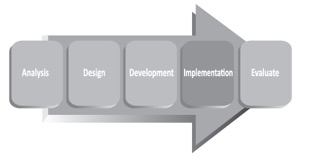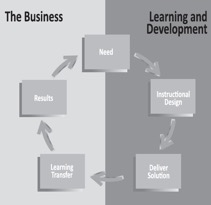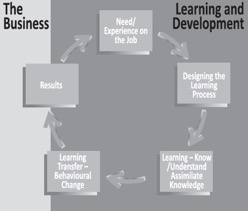
Using conventional approaches to training, an average of just 10 to 20 percent of learning makes it back to the workplace and contributes to better business outcomes. With the current emphasis on efficiency and cost-effectiveness, such a dismal record is no longer acceptable. This book, “Turning Learning into Action: A Proven Methodology for Effective Transfer of Learning,” provides the necessary tools to enable trainers, buyers of training, and Learning & Development (L&D) professionals to find ways to facilitate genuine behavioral change and accountability back in the workplace. The book is broken down into three parts:
- Part 1: The learning transfer challenge
- Part 2: The learning transfer solution
- Part 3: Making learning transfer happen and the benefits by stakeholder
The instructional design process of ADDIE (see Figure 1) has been the hallmark of good training for decades.
Figure 1 – The instructional design process as indicated by ADDIE

We have sought to understand how adults learn and have universally incorporated those elements into design and development—and yet training still fails. We have elevated content creation and delivery to an art form and implemented outstanding training and yet training still fails. We have collected happy sheets or invested in complex return on investment (ROI) calculations in our effort to evaluate training and yet training still fails. The only difference now is that we can quantify the failure. If ADDIE is effectively mastered and training effectiveness has still remained largely unchanged for decades, then clearly something is missing. If we have almost perfected each element of the instructional design process and the vast majority of training is still a colossal waste of time and money, then clearly there has to be something missing.
If we have embraced the 70/20/10 model and slashed our formal training budget, but the 70 percent of learning that takes place through on-the-job experience, projects, tasks, and problem solving is still not converting into business solutions and improved performance, then there still has to be something missing.
There is. What is missing is a proven transfer of learning process.
The adherence of ADDIE in one form or another has meant that everyone is trying to design a process that delivers learning rather than a process that delivers change. And for the record, as a tool to deliver learning, ADDIE is extremely good, but as a tool to deliver change, it is not. There are two distinct parts to effective training. The first is the transfer of learning to the participant. The second is the transfer of learning from the participant into the workplace, as evidenced by behavior change. ADDIE facilitates the first part brilliantly, but it skips the second part almost entirely.
The 70/20/10 model may redistribute where learning occurs in a business, but it does nothing to address whether that learning is being applied in the business. There are and always will be new ideas and frameworks being developed, because people are constantly drawn to the illusion of the easy solution, some magical switch that once flicked will miraculously close the gap between knowledge and application. There is no magic switch. We need to embrace the fact that helping people change is a very different process from helping them learn, and uploading the learning is a very separate process from downloading the learning.
Remember that when someone is commissioning a learning program, they don’t want the learning per se, they want the change the learning is going to give the participants and the subsequent business improvement that learning will deliver to the business. People may enjoy training and expect it as part of their remuneration package, but the purpose should always be to help people to change their behavior and improve their performance from A to B, because it is that improvement that ultimately will help move the business from A to B and beyond.
Behavior change is the key to massively improving results. ADDIE is devoted to delivering learning outcome rather than changes in performance or performance outcomes. Even when it comes to evaluation, the only level of evaluation that truly focuses on the measurement of performance outcomes is Level 3—behavior—and it is largely ignored.
If the accepted training design model allows us to effectively ignore performance outcomes in favor of learning outcomes, then it is hardly surprising that training fails to deliver real-world change on a consistent basis. And creating a new and innovative model about where that learning comes from won’t solve the issue either. Without the necessary focus on performance outcomes, transfer of learning has no universally applied strategy, there is no ownership of the process, and the “solutions” are piecemeal, ad hoc, and largely ineffective.
Just think about it: Training is created because of a business need (see Figure 2 below). What follows is analysis, instructional design, and delivery of the “solution.” Every business wants that training to impact performance in some way. But it is not happening—and it is not happening because of the distribution of training ownership. Traditionally, the L&D department owns half of the training cycle and the business owns the other half of the training. Once the need has been jointly discussed between the business unit and the L&D department, L&D will design and deliver the program. Then they pass implementation, transfer of learning, and result back to the business, either through performance appraisals, manager intervention, or some other business unit initiative. If, as the 70/20/10 model would suggest, 70 percent of learning occurs on the job, then the manager is even more responsible for the learning results. And yet considering the statistics of failed training, this learning loop is clearly not working.
Figure 2 – The current formal learning loop

Collectively, we need to shift the ownership of learning transfer so that L&D is much more involved in the results the business is getting (see Figure 3). Not only would it mean that learning transfer was effective, it would increase the visibility of learning and development.
Figure 3 – The revised formal learning loop

Chapter Summary
For training to be truly effective, it must adhere to the ADDIE model, be owned by the L&D department, and incorporate a proven transfer of learning strategy. Effective learning transfer is the missing link in learning, and it is just as relevant to on-the-job “70 percent learning” initiatives as it is to the “formal 10 percent learning” initiatives. If business is seeking a solution to a business problem or seeking sustained employee performance improvement, then a proven learning transfer process is the only viable solution.
Excerpt from Chapter 1 of “Turning Learning into Action: A Proven Methodology for Effective Transfer of Learning” by Emma Weber (Kogan Page, March 2014). For more information, visit: https://www.koganpage.com/product/turning-learning-into-action-9780749472221
Emma Weber is the founder and CEO of Lever – Transfer of Learning and developer of the Turning Learning into Action (TLA) methodology. Weber‘s firm belief, and the platform on which she has built her global business, is that the key aim of learning in the workplace is to create tangible business benefits. She established Lever to help organizations and their employees convert learning into effective action back on the job. Under her guidance, Lever now delivers TLA programs throughout 20 countries and in 12 languages. An authority on the transfer of learning, Weber has been a guest speaker on learning effectiveness at conferences in Australia, New Zealand, Malaysia, and the U.S. Her book, “Turning Learning into Action: A Proven Methodology for Effective Transfer of Learning,” was published in March 2014 by Kogan Page. Her second book, “Making Change Work: How to Create Behavioral Change in Organizations to Drive Impact and ROI,” co-authored with Jack and Patti Phillips of the ROI Institute, was published May 3, 2016, by Kogan Page. For more information, visit: https://www.koganpage.com/product/making-change-work-9780749477608. Fostering entrepreneurship is Weber’s other keen interest, and she has co-facilitated training at the Branson Centre of Entrepreneurship in South Africa.



